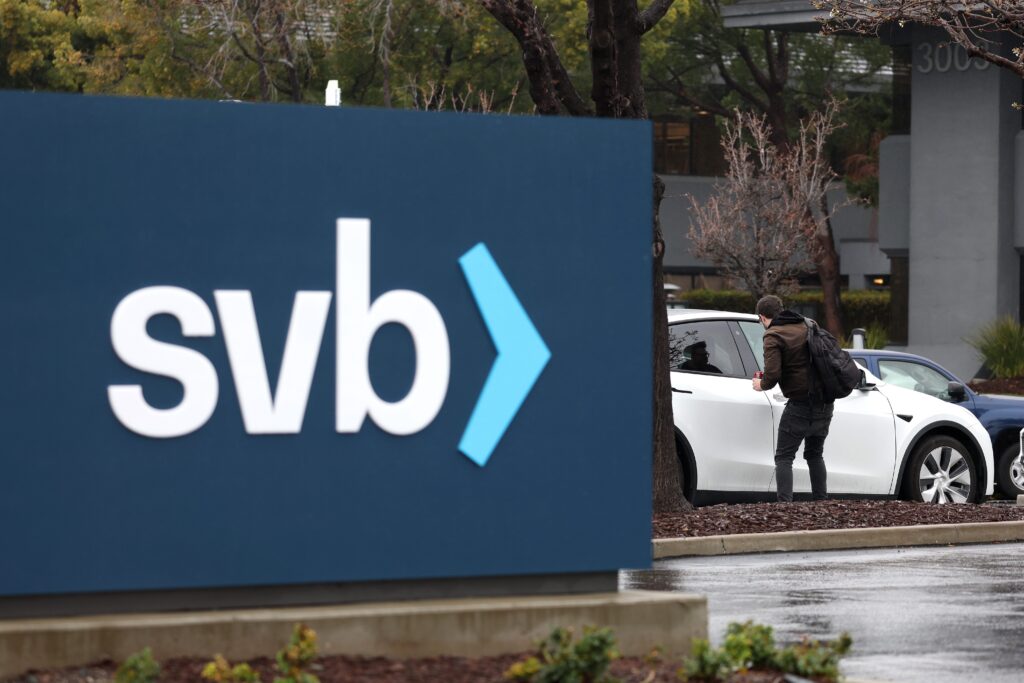- Silicon Valley Bank’s rapid implosion showed how bank runs can go at warp speed in the digital age.
- SVB’s customers tried to withdraw funds at a rate of nearly $500,000 per second Thursday.
- Bank regulation rollbacks by President Trump in 2018 have also been blamed for SVB’s demise.
If the spectacular collapse of Silicon Valley Bank has shown us one thing, it’s the speed at which a bank run can take place in the digital age.
Panicked SVB clients tried to withdraw $42 billion from the bank on Thursday — equivalent to nearly $500,000 per second over a 24-hour period — and the bank simply couldn’t meet the demand.
For context, the biggest bank run of the 2007-08 financial crash saw $16.7 billion withdrawn from Washington Mutual, a savings and loan bank, over the course of 10 days.
In an era when a bank’s customer base can demand instant money at the tap of a smartphone key or the click of a mouse, US lenders are sitting on an estimated $620 billion worth of paper losses from the same kind of assets that hurt SVB’s ability to meet a wave of withdrawals.
But while digital banking meant SVB’s collapse accelerated to warp speed, its foundations had been left shaky. For at least part of this we can thank Donald Trump’s rollback of banking regulations in 2018, which did away with so many of President Obama’s post-financial crisis protections.
The rise of digital banking
As banks moved on from the 2007-08 crisis, demand for mobile banking exploded, catalyzed in part by the launch of the iPhone in 2007. Digital banking, and the expectation of instantaneous transactions, is now the norm for the internet generation.
Commenting in a tweet Monday on SVB's collapse, Mohamed El-Erian, the chief economic advisor of Allianz, pointed to the "supersonic speed of information flows and deposit flight" in a world of "tech-enabled banking."
James Bianco, president of Bianco Research, said smartphones had removed "the frictions of standing in line" at banks and tellers being instructed "to count money slowly" if withdrawals spiked.
Bianco said SVB's collapse should "scare the hell" out of bankers and regulators worldwide. "The entire $17 trillion deposit base is now on a hair-trigger expecting instant liquidity," he said.
OpenAI CEO Sam Altman, formerly president of Silicon Valley startup incubator Y Combinator, which heavily depends on SVB, tweeted Sunday: "We really, really don't want depositors to start doubting their banks. The world has changed since 2008; the speed of a cascade could be very fast."
Trump tears up the post-crisis playbook
In the wake of the 2007-08 crisis, President Obama pushed through the Dodd-Frank Act to straighten out America's banking sector. In 2018, President Trump enacted significant changes to liberate all but the largest banks from Obama's safeguards.
Crucially, Trump's regulatory rollback meant banks were only considered "systemically important" — and therefore subject to closer federal oversight, including annual "stress tests" — if they had assets of $250 billion or more, as opposed to the $50 billion-plus required by Obama's rules.
SVB had $209 billion assets at the end of 2022, meaning it wasn't considered systemically important.
In other words, if Trump hadn't torn up the Dodd-Frank playbook, SVB would have been subject to an annual stress test by the Federal Reserve. The stress test, per the Fed, "assesses whether banks are sufficiently capitalized to absorb losses during stressful conditions" while continuing to go about their daily business.
SVB would also, pre-Trump, have been subject to stricter rules about how much capital it's required to hold and how liquid its assets need to be.
In the new era of high interest rates, SVB found itself sitting on paper losses from government bonds and mortgage-backed securities it bought when rates were much lower. And it wasn't able to liquidate these assets fast enough, and cover the shortfall from its losses, when its clients came calling with a collective demand for $42 billion in withdrawals.
Nigel Green, CEO of deVere Group, an independent financial adviser, said SVB's collapse had brought Trump-era deregulation into question. "It appears that the deregulation has allowed banks like SVB to take reckless risks," he said. "Now there needs to be a serious conversation about reversing the law to shore up confidence and to avoid further collapses."
Bernie Sanders was more forthright. "Let's be clear. The failure of Silicon Valley Bank is a direct result of an absurd 2018 bank deregulation bill signed by Donald Trump," the Vermont senator said in a statement Sunday.
Banks and their government overseers worldwide are waiting with bated breath to see whether SVB is only the first domino to fall, because lenders unable to meet mass withdrawals are mere taps or clicks away from a speedy wipeout.
